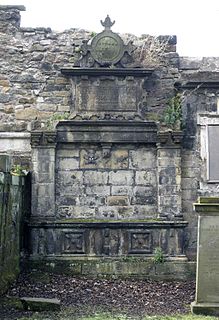Related Research Articles
George Heriot was a Scottish goldsmith and member of the Parliament of Scotland. He is perhaps best known as the father of the philanthropist George Heriot, his eldest son.

Adrian Vanson was court portrait painter to James VI of Scotland.

Gilbert Primrose was a Scottish surgeon who became Surgeon to King James VI of Scots and moved with the court to London as Serjeant-Surgeon to King James VI and I on the Union of the Crowns. He was Deacon of the Incorporation of Surgeons and Barbers of Edinburgh on three occasions.
Thomas Foulis was a Scottish goldsmith, mine entrepreneur, and royal financier.
Nicholas (Nicol) Uddert or Udward or Udwart or "Edward" was a 16th century Scottish merchant who served as Provost of Edinburgh in 1592/93.

The Entry of James VI into Edinburgh was a ceremony marking the coming of age of James VI of Scotland as an adult ruler on Friday 19 October 1579. James VI had spent his childhood at Stirling Castle. Now he came to Edinburgh to begin his adult rule.
Elizabeth Stewart, Countess of Arran was a Scottish aristocrat and political intriguer.

James Cockie was a goldsmith in Edinburgh. He helped mint coins in Edinburgh Castle and was hanged as a counterfeiter.
Alexander Clark of Balbirnie was a Scottish merchant and Provost of Edinburgh. He was closely involved with English diplomacy.
Archibald Stewart was a Scottish merchant and Provost of Edinburgh.

James Mosman was a Scottish goldsmith.
William Fairlie or Fairley was an Edinburgh merchant and burgess.

Murdoch Walker was a stonemason in 16th-century Edinburgh.
Michael Gilbert was an Edinburgh goldsmith and financier.
Michael Sym or Syme was a Scottish goldsmith who worked for Regent Morton.
Thomas Annand was a Scottish goldsmith based in Edinburgh.
Thomas Ewyn was a Scottish goldsmith working in Edinburgh.

David Schang was a Scottish carpenter and fortune-teller working in 16th-century Edinburgh.
John Provand was a Scottish merchant in 16th-century Edinburgh.

Alexander Oustean or Austin was a Scottish tailor and member of Edinburgh burgh council.
References
- ↑ Jean Munro & Henry Steuart Fotheringham, Edinburgh Goldsmith's Minutes (Edinburgh, 2006), pp. 28 A50, 225 C59.
- ↑ James David Marwick, Extracts from the Records of the Burgh of Edinburgh, 1573-1579 (Edinburgh, 1882), pp. 113-4.
- ↑ Calendar State Papers Scotland: 1574–1581, vol. 5 (Edinburgh, 1907), p. 357.
- ↑ Documents relative to the reception at Edinburgh of the Kings and Queens of Scotland, 1561–1650 (Edinburgh, 1822), pp. 12–14.
- ↑ Jean Munro & Henry Steuart Fotheringham, Edinburgh Goldsmith's Minutes: 1525–1700 (SRS: Edinburgh, 2006), p. 227.
- ↑ James Marwick, Extracts from the Records of the Burgh of Edinburgh, 1573-1579 (Edinburgh, 1882), pp. 143, 191.